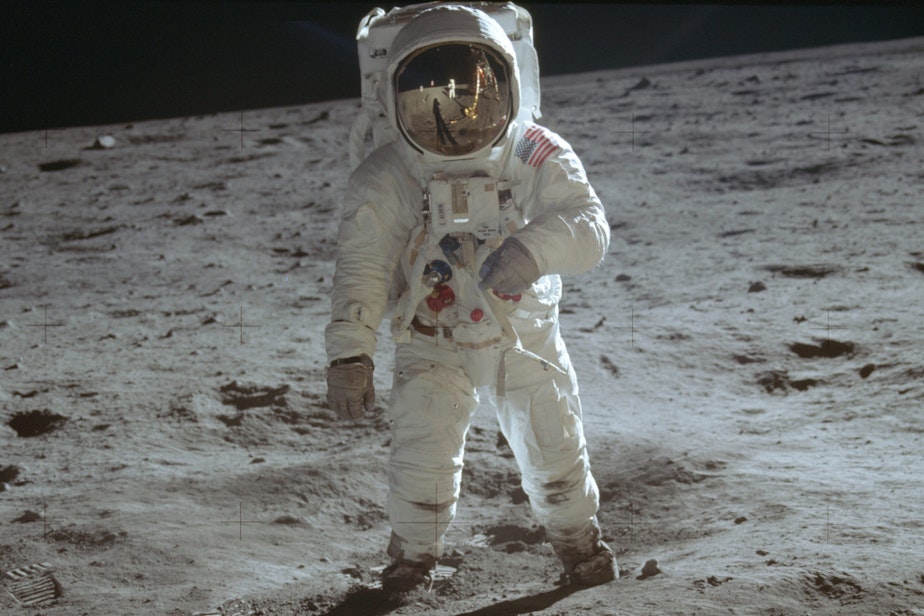Inside The 'Giant Leap' In Technology It Took To Land On The Moon

July 16 marks the 50th anniversary of the launch of Apollo 11, the first spaceflight to land on the moon. Saturday is the 50th anniversary of the moon landing, a goal that President John F. Kennedy first announced in 1961, well before the United States had the technology to carry out that mission. Charles Fishman documents the massive effort to land a man on the moon in his book “One Giant Leap: The Impossible Mission That Flew Us To The Moon.” Here & Now‘s Jeremy Hobson talks with Fishman (@cfishman) about the technology invented to make the moon landing possible.
Book Excerpt: ‘One Giant Leap’
by Charles Fishman
Boy this thing sure flies nice.
Pete Conrad, Apollo 12 commander at the controls of lunar module Intrepid, preparing to fly to a pinpoint landing on the Moon
Sponsored
The Moon has a smell.
It has no air, but it has a smell.
Each pair of Apollo astronauts to land on the Moon tramped lots of Moondust back into the lunar module—it was deep gray, fine-grained and extremely clingy—and when they unsnapped their helmets, they immediately noticed the smell.
“We were aware of a new scent in the air of the cabin,” said Neil Armstrong, the first man to set foot on the Moon, “that clearly came from all the lunar material that had accumulated on and in our clothes.” To Armstrong, it was “the scent of wet ashes.” To his Apollo 11 crewmate Buzz Aldrin, it was “the smell in the air after a firecracker has gone off.”
All the astronauts who walked on the Moon noticed it, and many of them commented on it to Mission Control. Harrison Schmitt, the geologist who flew on Apollo 17, the last lunar landing, said after his second Moon walk, “Smells like someone’s been firing a carbine in here.” Almost unaccountably, no one had warned lunar module pilot Jim Irwin about the dust. When he took off his helmet inside the cramped lunar module cabin, he said, “There’s a funny smell in here.” His Apollo 15 crewmate Dave Scott said: “Yeah, I think that’s the lunar dirt smell. Never smelled lunar dirt before, but we got most of it right here with us.”
Sponsored
Moondust was a mystery that the National Aeronautics and Space Administration had, in fact, thought about. Cornell University astrophysicist Thomas Gold warned NASA that the dust had been isolated from oxygen for so long that it might well be highly chemically reactive. If too much dust was carried inside the lunar module’s cabin, the moment the astronauts repressurized it with air and the dust came into contact with oxygen, it might start burning, or even cause an explosion. (Gold, who correctly predicted early on that the Moon’s surface would be covered with powdery dust, also had warned NASA that the dust might be so deep that the lunar module and the astronauts them-selves could sink irretrievably into it.)
Among the thousands of things they were keeping in mind while flying to the Moon, Armstrong and Aldrin had been briefed about the very small possibility that the lunar dust could ignite. It was, said Aldrin, “the worry of a few. A late-July fireworks display on the Moon was not something advisable.”
Armstrong and Aldrin did their own test. They took a small sample of lunar dirt that Armstrong had scooped into a lunar sample bag and put in a pocket of his spacesuit right as he stepped onto the Moon—a contingency sample in case, for some reason, the astronauts had to leave suddenly without collecting rocks. Back inside the lunar module the astronauts opened the bag and spread the lunar soil out on top of the ascent engine. As they repressurized the cabin, they watched to see if the dirt started to smolder. “If it did, we’d stop pressurization, open the hatch and toss it out,” explained Aldrin. “But nothing happened.”
From ONE GIANT LEAP by Charles Fishman. Copyright © 2019 by Charles Fishman. Excerpted with permission by Simon & Schuster, a Division of Simon & Schuster, Inc.
This article was originally published on WBUR.org. [Copyright 2019 NPR]
